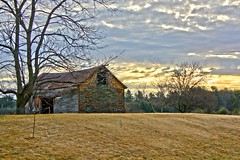| Barn HDR (Photo credit: little.tomato) |
It may have been the title of Dan Denvir's article for Salon.com that first caught my attention, "There really is a war on Christmas!" However, the article's tagline is what got me thinking and inspired this post: "And it's being fought by some of the bravest atheists in the country, nonbelievers in rural areas and the heartland." No, this is not another post about Christmas or the imaginary war on Christmas. Instead, I'd like to take a look at Denvir's thesis that those wanting to find the angriest atheists will do so in small towns located throughout the central U.S. rather than in big cities on the coasts.
Here is how he put it:
Forget Hollywood and the Upper West Side. The angriest atheists are from the American heartland, where they live surrounded by the faithful.
Denvir cites Pew data from 2007 showing that rural atheists were more likely to report a conflict between the religious and non-religious than urban respondents. This is something I hadn't thought much about before, but it does make sense. Where an atheist lives, at least in terms of the implications this has for the manner in which the atheist encounters religion, probably has something to do with how the atheist feels about religion.
Denvir quotes Phil Zuckerman, a sociologist at Pitzer as saying, "Here's the bottom line: Where religion is weak, atheism is weak. Where religion is strong, atheism is strong." Here's how Zuckerman explained the differences between atheists living in rural settings from their urban counterparts:
In small-town USA, people are much more likely to be anti-religious because they have religion thrown in their face all the time — prayers at little league, prayers at city council meetings, Nativity scenes and Ten Commandments billboards, preachers on the radio and TV, etc. — and their lack of religion is often associated with being immoral.
There is nothing particularly surprising about this idea. After all, secular activism in the U.S. is largely a reaction to overreaches by the Christian majority. If they did not keep insisting on putting their nativity scenes on public property, one would not hear many atheists talking about nativity scenes.
I believe that the ideas in this article can be extended in a couple of important ways. First, I do not think that the rural vs. urban dimension is necessarily the driving factor. One could live in a progressive section of a small town and be relative free from religious influence, and one could live in an extremely religious pocket of a major city and encounter it every day. Population density is certainly relevant, but the unobtrusive-obtrusive nature of the religion one encounters is probably even more important.
Second, I think this core idea can (and has) been examined from a temporal dimension. That is, atheism tends to be more assertive in times of mass religious overreach. We've all seen this over the past decade. The more power the religious right attempts to exert, the greater the need for secular activism. If they would truly bow out of politics, organized atheism probably would not last very long.
